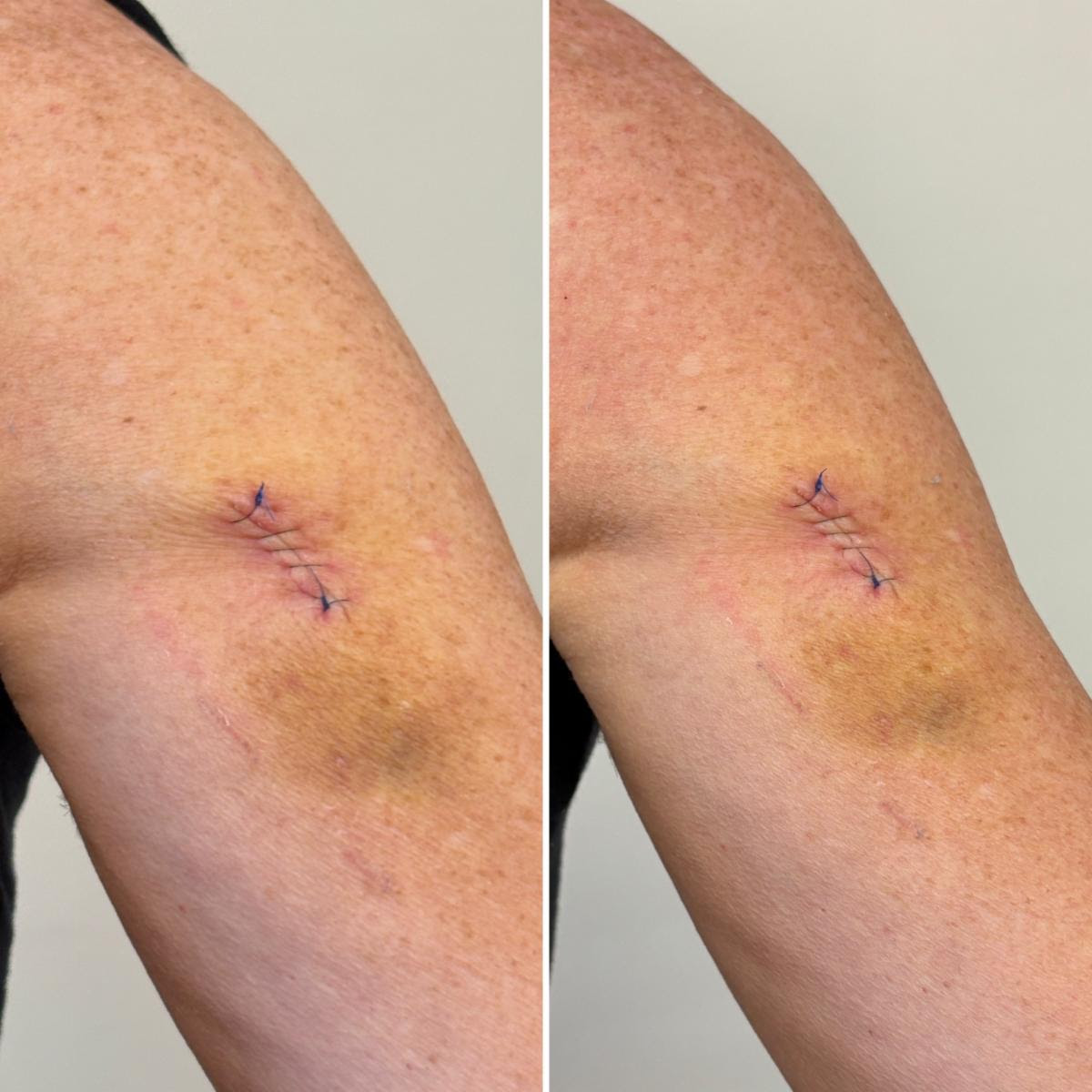Biopsies and ‘Spot’ removals leave lasting impacts beneath the surface
The hidden impact of biopsies and skin procedures on your muscles
Most of us expect the scars from dermatology procedures to heal and fade over time. What we don’t expect is how these procedures can quietly disrupt our muscles, leading to changes in strength, posture, and even joint health over the years.
As we age, most of us add regular dermatology skin checks to our health routines. By our mid-30s or 40s, these visits are as routine as dental cleanings. Every so often, the dermatologist finds a suspicious spot.
Sometimes, it’s just a quick biopsy. Other times, there’s a deeper removal to ensure “clean margins.” These procedures save lives — but they can leave hidden effects that go far beyond the skin.
Natalie’s Story: The Unseen Impact of a Small Spot
Natalie came to our office for a follow-up on a different issue. However, she had a recent dermatology procedure for a tiny suspicious spot, just 1/16 of an inch wide.
The removal was quick and successful, but deep. That little spot adjacent her biceps muscle turned into a two-inch incision which was tied together with gnarly-looking stitches. (Yes, that’s the photo!)
Although it was only a week old, she already noticed unusual tightness and discomfort in her arm and shoulder. We spent some of the session time addressing the after-effects of this procedure.
What we found surprised her:
- Biceps Activation Impacted: The natural “switch” between her wrist movement and bicep activation had been disrupted, leaving her arm feeling weak.
- Postural Shift Forward: The surgical closure created tension that pulled her upper arm and shoulder forward, changing her posture and movement.
After less than a week, her body was already compensating in ways that, if left unaddressed, would likely lead to bigger problems down the road. These types of issues don’t resolve with time or exercise.
I knew the differences from left (before Bridging) to right (after Bridging® resets) may seem subtle, so I consulted a wound care specialist (RN, CWCN) for their unprompted observations.
“The photo on the right shows healing. There is evidence of decreasing inflammation, well-approximated margins, decreasing edema (swelling), and fading bruising.”
The photos were taken about 30 minutes apart from each other. The specialist was surprised to hear this.
“Wow, 30 minutes, that’s crazy! I was thinking a few days later.”
Yes, that’s the power of the body to heal when Bridging provides essential support.
The Long-Term Effects: More Than “Just Aging”
While the photos couldn’t capture the internal impacts of the procedure, Natalie could feel the difference immediately. Over time, the noted compensations would otherwise show up as issues many people mistakenly attribute to getting older:
- Weakened Grip Strength – When the bicep can’t coordinate properly with the hand, strength declines. Grip strength is a well-known predictor of healthy aging.
- Elbow Tendonitis – Misaligned tension puts extra stress on the elbow joint, causing pain and inflammation.
- Frozen or Impinged Shoulder – As the shoulder shifts forward, range of motion decreases, leading to stiffness and discomfort.
- Rounded Posture – Forward-pulled muscles cause the shoulders to round, straining the neck and back while impacting balance and vision.
In just one session of Bridging resets, Natalie’s arm felt stronger, her posture improved, the scar’s tight “puckered” look softened, and she felt more relaxed.
Why These Changes Matter
Skin cancer removals and other dermatology procedures are essential for your health—but they can leave behind hidden disruptions that limit your movement and strength. These aren’t just cosmetic changes; they directly affect your ability to stay active and independent.
Ignoring these small changes often means years later, you’re left wondering why everyday activities feel harder, why your shoulder aches, or why your balance isn’t what it used to be.
Help Beneath the Surface to Heal Too …
If you’ve had skin cancer removals, biopsies, or other dermatological procedures, Bridging can help you:
- Restore strength and coordination after scar-related disruptions.
- Improve posture and balance by addressing hidden muscle compensations.
- Prevent future pain and stiffness by fixing the root issue, not just the symptoms.
Most clients feel tangible improvements in 1–3 sessions, as they return to their usual activities.

